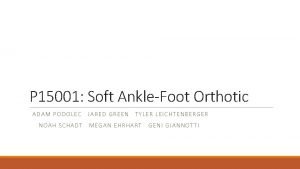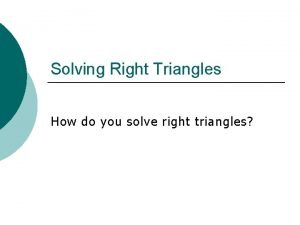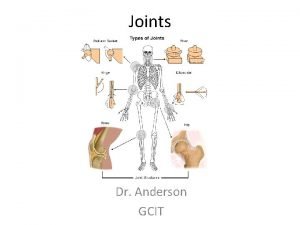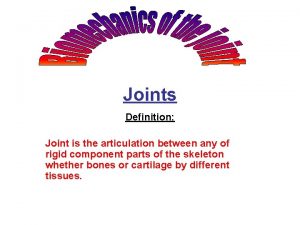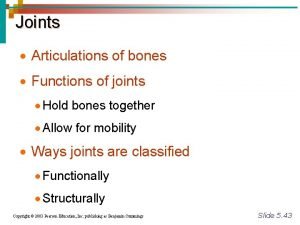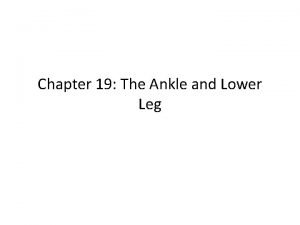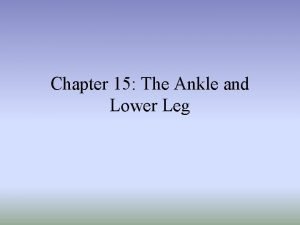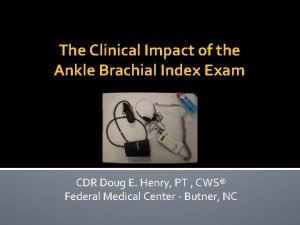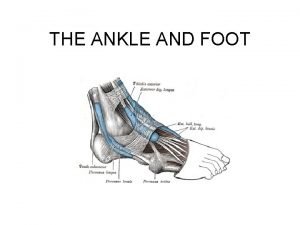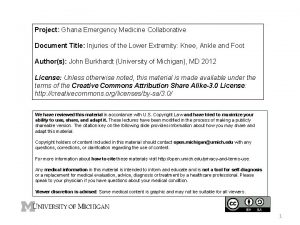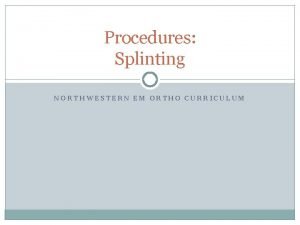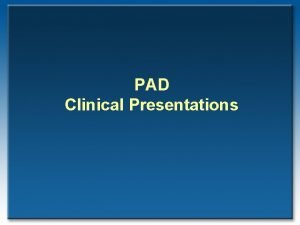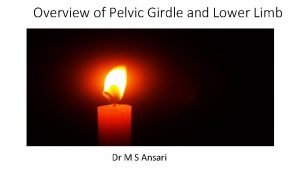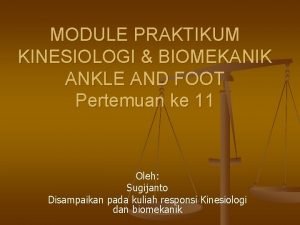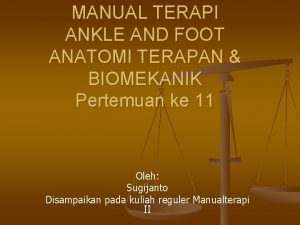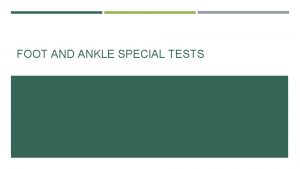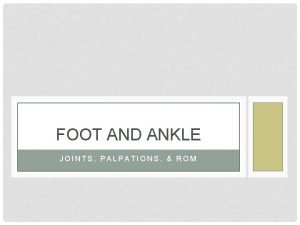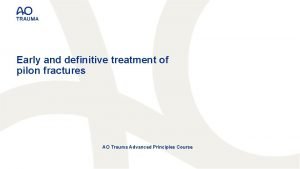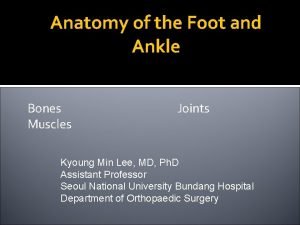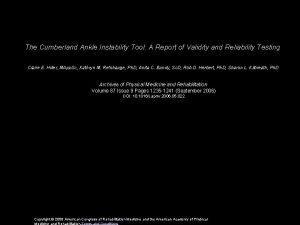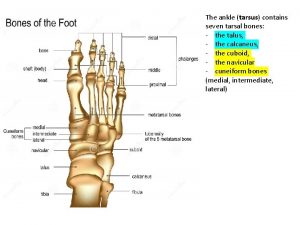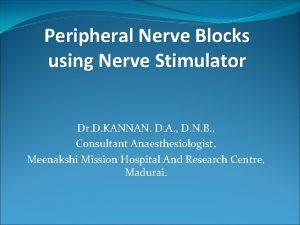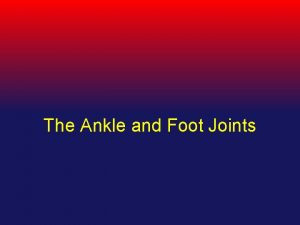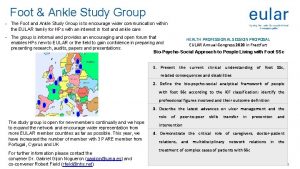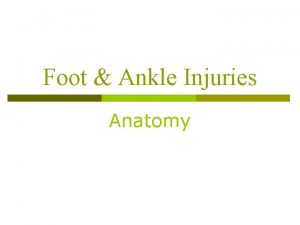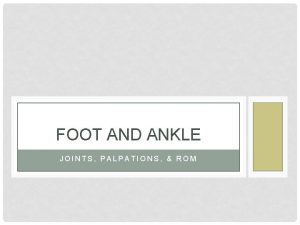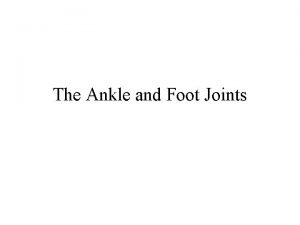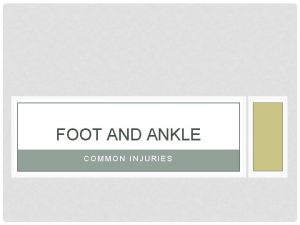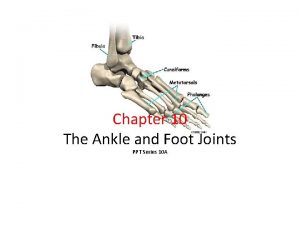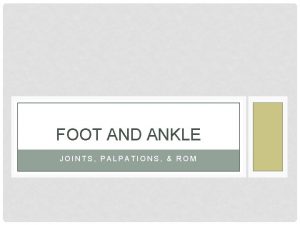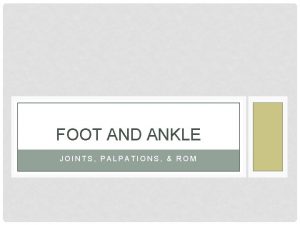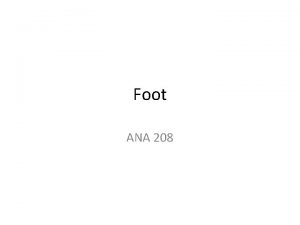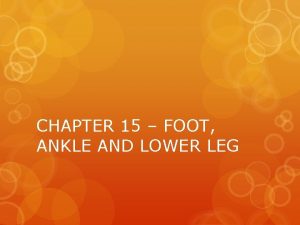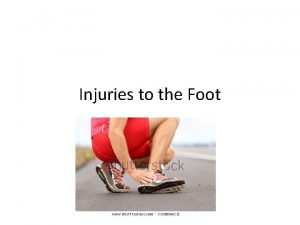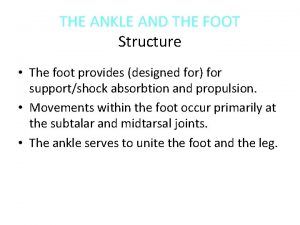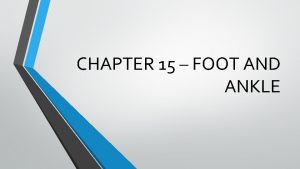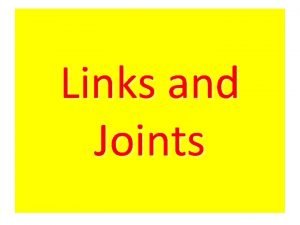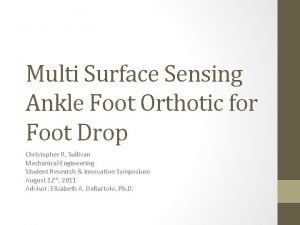The Ankle and Foot Joints Function of the






























- Slides: 30

The Ankle and Foot Joints

Function of the foot • Provide a stable platform • Generate propulsion • Absorb shock

Bones • • Ankle + foot = 28 bones foot = 26 bones Leg: tibia, fibula Foot: – Tarsals (7): talus, calcaneus, navicular, cuboid, and cuneiforms (3) – Metatarsals (5) – Phalanges (14)

Joints • Tibiofibular: – articulation between tibia and fibula • amphiarthrodial joint • Ankle joint – Talocrural • articulation between talus and tibia; talus and fibula • classified as a ginglymus

Joints • Subtalar joint – articulation between talus and calcaneus – classified as arthrodial (gliding) joint • Transverse tarsal joint – articulation between talus, navicular, calcaneus and cuboid bones – classified as arthrodial joint

Joints • Tarsometatarsal – tarsal bones and metatarsal – classified as arthrodial (gliding) joints • Metatarsophalangeal – metatarsals and phalanges – classified as condyloid • Interphalangeal joints (proximal and distal) – phalangeal bones – ginglymus

Arches of the foot • Medial longitudinal arch – calcaneus, talus, navicular, cuneiforms (3), and medial metatarsals (3). • Lateral longitudinal arch – calcanueus, cuboid, lateral metatarsals (4 & 5) • Transverse arch – across metatarsals

Classifying Arch Type • Pes Planus: Flat foot • Pes Cavus: High Arch • Normal

Movements • Ankle joint – dorsiflexion: “raising the toes” – plantarflexion: “point the toes” • Subtalar & Transverse tarsal joints – Calcaneal inversion and eversion • Interphalangeal joints – flexion – extension

Movements • Supination • inversion • plantar flexion • adduction • Pronation • eversion • dorsiflexion • abduction

Summary • Bones of the foot: – tarsals, metatarsals, phalanges • Joints of the foot and ankle – – – talocrural (ankle) subtalar transverse tarsal metatarsalphalangeal interphalangeal • Movements – dorsiflexion/plantarflexion (ankle joint) – inversion/eversion (subtalar & transverse tarsal) – flexion and extension of toes about the interphalangeal joints

Muscles • • Plantar flexors Dorsi flexors Evertors Invertors

Plantar Flexors • • • Gastrocnemius Flexor digitorum longus Peroneus longus Plantaris Soleus Tibialis Posterior

Dorsiflexors • Tibialis anterior • Peroneus tertius • Extensor digitorum longus

Invertors • Tibialis anterior • Tibialis posterior • Flexor hallucis longus

Evertors • • Peroneus longus Peroneus brevis Peroneus tertius Extensor digitorum longus

Extensor digitorum longus (p 44) • Origin – lateral condyle of tibia – upper 3/4 of anterior aspect of fibula • Insertion – superior aspect of foot, middle and distal phalanges of four lesser toes • Action – Extension of four lesser toes – dorsal flexion – eversion

Extensor hallucis longus (p 45) • Origin – fibula, middle aspect of anterior fibula • Insertion – superior aspect of foot, base of distal phalanx of great toe • Action – dorsiflexion – extension of great toe

Peroneus tertius (p 46) • Origin – fibula, anterior-lateral surface of lower 1/3 of fibula • Insertion – superior aspect of foot, base of fifth metatarsal • Action – Eversion – Dorsal flexion

Tibialis anterior (p 47) • Origin – Lateral condyle of tibia – Upper two-thirds of anterior-lateral aspect of tibia • Insertion – plantar surface of 1 st (medial) cuneiform and 1 st metatarsal • Action – Dorsal flexion – inversion

Peroneus brevis (p 48) • Origin – fibula, lower two-thirds, lateral aspect • Insertion – 5 th metatarsal tuberosity • Action – eversion

Peroneus longus (p 49) • Origin – lateral surface of tibia – fibula, upper two-thirds of lateral aspect of fibula • Insertion – inferior aspect of foot, 1 st cuneiform and 1 st metatarsal bones • Action – Eversion – Plantar flexion

Flexor digitorum longus (p 50) • Origin – tibia, middle third, posterior aspect • Insertion – plantar surface of foot, distal phalanx of each of the four lesser toes (no big toe) • Action – ‘toe’ flexion – plantar flexion

Flexor hallucis longus (p 51) • Origin – fibula, lower two-thirds, posterior aspect • Insertion – plantar aspect of foot, base of distal phalanx of big toe (‘hallucis’) • Action – ‘big toe flexion’ – inversion

Gastrocnemius (p 52) • Origin – medial and lateral epicondyle of the femur • Insertion – posterior surface of calcaneus • Action – plantar flexion – knee flexion

Soleus (p 54) • Origin – upper 1/3 posterior shaft of fibula – posterior surface of head of fibula – popliteal line – middle 1/3 of medial border of tibia • Insertion – Posterior surface of the calcaneus • Action – Plantar flexion

Note • Gastrocnemius and Soleus muscles have a common tendon/insertion (calcaneal tendon or Achilles tendon) • Some texts refer to the combination of the gastrocnemius and soleus as the triceps surae (three headed muscle).

Plantaris (p 53) • Origin – posterior surface of lateral epicondyle of femur • Insertion – posterior surface of calcaneus • Action – plantar flexion

Tibialis Posterior (p 55) • Origin – middle 1/3 of posterior-lateral surface of tibia – middle 1/3 of posterior-medial surface of fibula • Insertion – plantar surface of foot, lower inner surfaces of navicular, cuneiforms, and 2 nd & 3 rd metatarsals • Action – plantar flexion – inversion

Summary of muscles • Plantar flexors – gast. , sol. , flx digitorum long. , per longus, tib post, plantaris • Dorsi flexors – tib ant, per tertius, ext dig long • Evertors – per longus, brevis, tertius, ext dig longus • Invertors – tib ant & post, flx hallucis long
 Physiology of the foot and ankle
Physiology of the foot and ankle Ankle foot orthoses
Ankle foot orthoses Foot orthosis instant design challenge
Foot orthosis instant design challenge Put your right foot in
Put your right foot in Hypotenuse formula for right triangle
Hypotenuse formula for right triangle Function of joints
Function of joints Functions of joints
Functions of joints Amphiarthrosis examples
Amphiarthrosis examples Chapter 19 worksheet the ankle and lower leg
Chapter 19 worksheet the ankle and lower leg Chapter 15 worksheet the ankle and lower leg
Chapter 15 worksheet the ankle and lower leg Abi test
Abi test Ankle eversion
Ankle eversion Plantar flexors
Plantar flexors Hip er rom
Hip er rom Ottowa ankle rules
Ottowa ankle rules Long arm post mold splint
Long arm post mold splint Tuberositas calcanei
Tuberositas calcanei Abi severity scale
Abi severity scale Ankle jerk
Ankle jerk Biomekanik ankle
Biomekanik ankle Mtp 1 anatomi
Mtp 1 anatomi Ankle special test
Ankle special test Toes rom
Toes rom Chaput fragment ankle
Chaput fragment ankle Ankle muslces
Ankle muslces The cumberland ankle instability tool
The cumberland ankle instability tool Seven ankle bones
Seven ankle bones Perpneal tendon
Perpneal tendon Human crutch carry
Human crutch carry Dorsum leg
Dorsum leg Sustentaculum tali
Sustentaculum tali

